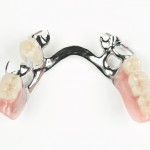
Oral health-related quality of life (OHRQoL) is an increasingly important element in assessing oral health. Tooth loss has a negative effect on OHRQoL although, a shortened dental arch (SDA) of ten pairs of occluding anterior and premolar teeth is considered sufficient to provide good oral function. Whether prosthetic replacement with removable partial dental prosthesis (RPDP) or implant-supported fixed partial dental prosthesis (IFPDP) improves OHRQoL is of clinical interest.
The aim of this review was to compare the effect on oral health-related quality of life (OHRQoL) between the shortened dental arch (SDA) concept and conventional treatment with removable partial dental prosthesis (RPDP) or implant-supported fixed partial dental prosthesis (IFPDP) – for distal extension of edentulous space in the posterior area.
Methods
Searches were conducted in the Medline and Cochrane Central Register of Controlled Trials databases. Two reviewers independently selected studies. Randomised controlled trials (RCTs) or controlled trials (CCTs) comparing OHRQoL between RPDPs or IFPDPs for restoration of partially edentulous arches up to molars and SDA or non-restored SDA using validated instruments were considered. SDA was defined as a partially dentate arch with premolar occlusion, without any molars in at least one quadrant, and with all anterior teeth intact or restored with fixed prosthesis. Two reviewers independently assessed risk of bias using the Cochrane tool and meta-analysis were carried out.
Results
- 3 studies (2 RCTs; 1 CCT) involving a total of 516 patients were included
- All 3 studies used the oral health impact profile (OHIP) for OHRQoL evaluation.
- Data from 270 patients at 6 six months and 266 patients at 12 months was pooled in a meta-analysis.
- For the RPDP group a non-significant higher integrated OHIP summary scores (greater OHRQoL impairment) was seen than in the SDA group at 6 &12 months post-treatment.
- For clasp-retained RPDPs modest but non-significant higher OHIP scores were seen than in the SDA group at 6 and 12 months post-treatment
- The IFPDP group exhibited moderately, but not significantly, lower OHIP scores than the SDA group at 6 and 12 months post-treatment
Conclusions
The authors concluded: –
Within the limited evidence obtained from hitherto published RCTs and non-RCTs, the SDA concept appears to be as feasible as RPDP restoration with respect to OHRQoL in partially dentate patients. Further clinical trials are required to clarify the effect of IFPDP restoration on OHRQoL.
Comments
This review covers similar ground to a 2014 review by Khan et al (Dental Elf – 15th Jul 2014). The Khan review searched a broader selection of databases that the current one, including 5 studies rather than the 3 included here. While there is a limited amount of evidence available both reviews suggest that there is support for the SDA concept having a positive effect on OHRQoL. However more high quality studies are needed in particular to to address longer-term issues such as the survival of the SDA.
Links
Primary paper
Fueki K, Baba K. Shortened dental arch and prosthetic effect on oral health-related quality of life: a systematic review and meta-analysis. J Oral Rehabil. 2017 Jul;44(7):563-572. doi:10.1111/joor.12511. Epub 2017 Apr 21.Review. PubMed PMID: 28370239.
Other references
Dental Elf – 6th Nov 2015
Shortened dental arch and oral health related quality of life
Dental Elf – 15th Jul 2014
Review suggests the shortened dental arch may be an acceptable approach

[…] Shortened dental arch: impact on oral health-related quality of life […]